|
|
|
Sort Order |
|
|
|
Items / Page
|
|
|
|
|
|
|
| Srl | Item |
| 1 |
ID:
137890
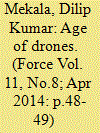

|
|
|
|
|
| Summary/Abstract |
Taranis, a top secret unmanned aerial vehicle (UAV), which is considered to be the most advanced aircraft ever built by British engineers, successfully carried out its first flight tests in August 2013. The information, however was released to the media only in February 2014 by the UK ministry of defence (MoD) and the manufacturer BAE systems. “The UK has developed a significant lead in understanding unmanned aircraft which could strike with precision over a long range whilst remaining undetected,” said a statement from BAE systems. “The technological advances made through Taranis will also help the UK MoD and Royal Air Force (RAF) make decisions on the future mix of manned and unmanned fast jet aircraft and how they will operate together in a safe and effective manner for the UK’s defence”.
|
|
|
|
|
|
|
|
|
|
|
|
|
|
|
|
| 2 |
ID:
128775
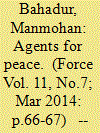

|
|
|
| 3 |
ID:
111276
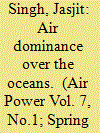

|
|
|
| 4 |
ID:
119317
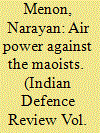

|
|
|
| 5 |
ID:
130115
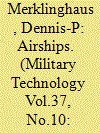

|
|
|
|
|
| Publication |
2013.
|
| Summary/Abstract |
Since the Civil War, when Union Soldiers utilised hot air balloons to serve as a surveillance platform, lighter than air technology has been a part of the military's inventory. As US forces began a troop surge in Afghanistan while maintaining security in Iraq the need to provide soldiers with a persistent view of the battlefield was paramount.
The primary goal of Millennium Airship is to design, engineer, build, market and operate the world's first Heavy-Lift Air Vehicle that is lighter-than-air, all-weather, amphibious semi-rigid, multi-mission, hybrid. The key feature of this aircraft will be in that it is so manoeuvrable that it can operate in and out of virtually anywhere (land or sea) where there is enough space to accommodate its size.
|
|
|
|
|
|
|
|
|
|
|
|
|
|
|
|
| 6 |
ID:
138623
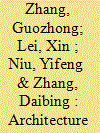

|
|
|
|
|
| Summary/Abstract |
Although UAV systems are currently controlled by a group of people, in the future, increased automation could allow a single operator to supervise multiple UAVs. Operators will be involved in the mission planning, imagery analysis, weapon control, and contingency interventions. This study examines the architecture and prototype of multiple UAVs supervisory control system. Firstly, the architecture for testing and evaluating human supervisory system controlling multiple UAVs is devised and each sub-system is described in detail. Then a prototype test bed of multiple UAVs supervisory control for demonstrating architecture and adaptive levels of autonomy is built. Finally, with the test bed, the impact of dynamic role allocation on system performance is studied based on quantitative criteria of wait times and operator utilisation. It is shown by simulation that dynamic role allocation can effectively shorten wait times, and eventually improve the system performance.
|
|
|
|
|
|
|
|
|
|
|
|
|
|
|
|
| 7 |
ID:
130672
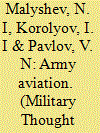

|
|
|
|
|
| Publication |
2014.
|
| Summary/Abstract |
The author examine the trends toward change in modern day military operations and define the role and place of army aviation in ground fighting. They show that it has a key role in operations today and is a major component of the fire system in confrontation with an adversary.
|
|
|
|
|
|
|
|
|
|
|
|
|
|
|
|
| 8 |
ID:
122421
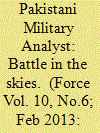

|
|
|
| 9 |
ID:
176369
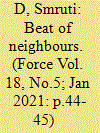

|
|
|
| 10 |
ID:
183163
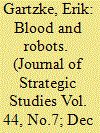

|
|
|
|
|
| Summary/Abstract |
New technologies such as Remotely Piloted Vehicles (RPVs) make it possible to remove human beings from direct involvement in combat. How will this evolving dynamic affect the practice and purposes of political violence? Will conflict become ‘costless’ in human terms as machines replace people on the front lines or will the logic of war continue to call for human sacrifice? While considerable attention has been devoted to the role of technology in transforming warfare, little is known about how new modes of combat will affect established motives for using force. I explore these political dimensions of new modes of conflict, drawing three basic conclusions. First, to the degree that substituting machines for humans lowers the costs for fighting, conflict will become more frequent, but less definitive. Second, in a reversal of previous trends, battlefield automation promises disproportionately to revitalise ground elements of military organisations. Finally, regrettably, new technologies should weaken inhibitions against targeting civilians.
|
|
|
|
|
|
|
|
|
|
|
|
|
|
|
|
| 11 |
ID:
138288


|
|
|
|
|
| Summary/Abstract |
North Atlantic Treaty Organization (NATO) members such as Canada and Denmark have transformed their military forces to better engage in expeditionary warfare. They are incorporating advanced technologies to find and strike targets precisely from great distances at little risk to themselves. The persistence of unmanned aerial vehicles (UAVs) represents the next step in modern airpower’s long-range reconnaissance/precision strike complex and has transformed ground operations. Nonetheless, operational requirements in Afghanistan caught Canada and Denmark flat-footed. Ultimately, Canada effectively used UAVs while Denmark could not. Moreover, neither state has a UAV capability beyond small tactical systems (although each has plans to develop or join in the development of larger ones). The Canadian and Danish experiences suggest that ground forces are most likely to acquire and integrate small UAVs into their force structures and concepts of operation and that the air forces of small- and medium-sized Western countries will likely do so only in cooperation with others. It is here that the Canadian and Danish UAV paths may yet again cross.
|
|
|
|
|
|
|
|
|
|
|
|
|
|
|
|
| 12 |
ID:
128666
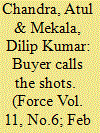

|
|
|
| 13 |
ID:
115963
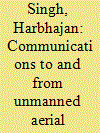

|
|
|
| 14 |
ID:
122037
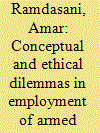

|
|
|
| 15 |
ID:
119436
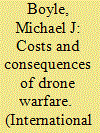

|
|
|
|
|
| Publication |
2013.
|
| Summary/Abstract |
One of the distinctive elements of President Barack Obama's approach to counterterrorism has been his embrace of Unmanned Aerial Vehicles (UAVs), or drones, to target terrorist operatives abroad. The Obama administration has used drones in active theatres of war, such as Afghanistan, but it has also dramatically increased the number of drone attacks launched by the CIA in other countries, such as Pakistan, Yemen and Somalia. The conventional wisdom on drone warfare holds that these weapons are highly effective in killing terrorist operatives and disabling terrorist organizations, while killing fewer civilians than other means of attack.
This article argues that much of the existing debate on drones operates with an attenuated notion of effectiveness that discounts the political and strategic dynamics - such as the corrosion of the perceptions of competence and legitimacy of governments where drone strikes take place, growing anti-Americanism and fresh recruitment of militant networks - that reveal the costs of drone warfare. Focusing particularly on drone use in Pakistan, Yemen and Somalia, the article suggests that the Obama administration's counterterrorism policy operates at cross-purposes because it provides a steady flow of arms and financial resources to build up governments whose legitimacy it systematically undermines by conducting unilateral strikes on their territory.
It concludes that the US embrace of drone technology is a losing proposition over the long term as it will usher in a new arms race and lay the foundations for an international system that is increasingly violent, destabilized and polarized between those who have drones and those who are victims of them.
|
|
|
|
|
|
|
|
|
|
|
|
|
|
|
|
| 16 |
ID:
130117
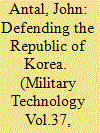

|
|
|
|
|
| Publication |
2013.
|
| Summary/Abstract |
South Korea takes its security issues very seriously. For years the Republic of Korea (ROK) relied on for eign military equipment, primarily from the US, but as the South Korean economy surged, ROK industries became leaders in military technology development and production. One of the areas that the ROK has excelled is in the area of unmanned robotic military systems. This article looks at some of the unmanned systems (UnS) currently developed by the South Korean defence industry.
|
|
|
|
|
|
|
|
|
|
|
|
|
|
|
|
| 17 |
ID:
130667
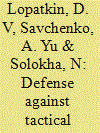

|
|
|
|
|
| Publication |
2014.
|
| Summary/Abstract |
The article focuses on tactical unmanned aerial vehicles (UAVs) and the need to develop an effective defense against drone attacks. Existing weapons and ways to defend against drones are presented. Problems discussed include challenges in detecting and destroying small size UAV's or drones. Options for defending against tactical drones including the use of laser as weapon, powerful electromagnetic impulses that disable drone equipment and drone hunter-killers are also presented.
|
|
|
|
|
|
|
|
|
|
|
|
|
|
|
|
| 18 |
ID:
130254
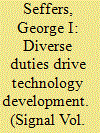

|
|
|
| 19 |
ID:
130342


|
|
|
|
|
| Publication |
2014.
|
| Summary/Abstract |
As the U.S. government winds up an interagency review of rules governing the export of large drones, the conflicting goals of nonproliferation and commerce are creating a new test of the 27-year-old Missile Technology Control Regime (MTCR). Observers do not expect big changes to the MTCR, which seeks to prevent the proliferation of unmanned systems capable of delivering weapons of mass destruction. The MTCR, a voluntary arrangement that now includes 34 countries, originally was intended to curb the spread of ballistic missiles and unmanned vehicles capable of carrying nuclear weapons. In 1993 it was amended to control systems carrying any weapons of mass destruction. It has become Washington's chief tool for controlling the spread of armed drones. "It's quite unlikely that we will see any radical change in the MTCR," Eric McClafferty, an attorney at Kelley Drye and Warren, a law firm in Washington that represents UAV manufacturers, said in a March 19 interview. "That said, there's a lot of pressure on the U.S. government to liberalize controls to make sure the U.S. doesn't get left behind in this market." The conflict has played out in a series of closed-door meetings over the last two months among the State, Defense, and Commerce departments as officials seek to update U.S. policy toward the burgeoning UAV market. Industry representatives have made their views known via technical committees that advise policymakers in these departments. "It's a pretty contentious fight" between the State Department's Bureau of International Security and Nonproliferation and the Pentagon's Defense Technology Security Administration, said Micah Zenko, a fellow at the Council on Foreign Relations, in a March 17 interview. The State Department says that "if you pull at the thread of MTCR, you will weaken the nonproliferation regime as a whole. The other side says the international market is going to supply these UAVs anyway," Zenko said. The heart of the issue is what kind of UAVs U.S. manufacturers can sell overseas. The MTCR imposes a "presumption of denial" for the export of so-called Category 1 UAV's, which are drones that can travel more than 300 kilometers with a payload of more than 500 kilograms. Drones that do not have those capabilities are classified as Category 2 UAVs and are not subject to such restrictive criteria. Two drones currently classified as Category 1-the Reaper, formerly known as the Predator, and the Global Hawk-have played a central role in U.S. aerial attacks on suspected Islamic militants in Pakistan, Somalia, and Yemen. Washington has approved the sale of an armed drone to only one country, the United Kingdom, although unarmed versions of these drones have been sold to Italy and South Korea.
The stakes of the MTCR review process are large politically and economically, observers say.
|
|
|
|
|
|
|
|
|
|
|
|
|
|
|
|
| 20 |
ID:
131319
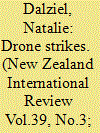

|
|
|
|
|
| Publication |
2014.
|
| Summary/Abstract |
As New Zealand's role in Afghanistan comes to a close, the War on Terror has been relegated to the backseat of the New Zealand public's consciousness, albeit prematurely so. With the first New Zealander killed in a drone strike in Yemen, it is timely that New Zealand reconsider its support for a tactic that opponents argue is itself an act of terrorism. As yet no consensus has been reached as to whether drone strikes constitute a breach of international law. We must, therefore, base our assessment on whether the tactic is ethically and strategically flawed. With every hell-fire missile that Nobel Peace Prize winning Barack Obama rains down on al-Qaeda and any civilians unfortunate enough to be in the way, a New Zealand decision on this question becomes more urgent.
|
|
|
|
|
|
|
|
|
|
|
|
|
|
|
|
|
|
|
|
|